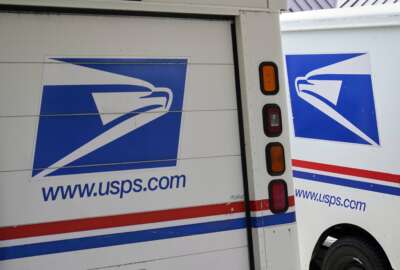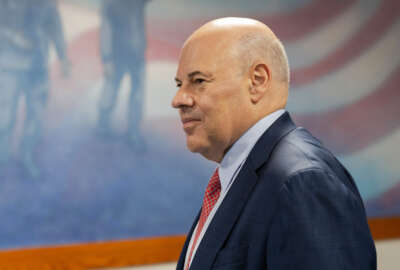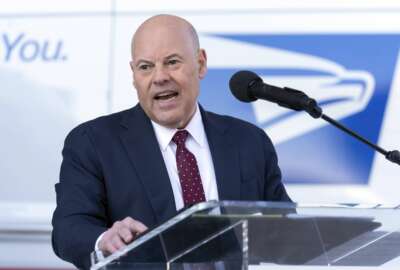Exclusive
USPS plans to cut $5B in costs, grow revenue to avoid running out of cash in coming years
Postmaster General Louis DeJoy is telling Congress that implementing these plans is necessary to keep USPS from running out of cash in the coming years.
The Postal Service is looking to cut $5 billion from its operating costs and grow its revenue by the same amount over the next two years to overcome its long-term financial challenges.
Postmaster General Louis DeJoy is telling Congress that implementing these plans is necessary to keep USPS from running out of cash in the coming years.
DeJoy, in a Jan.10 letter obtained by Federal News Network, told congressional leaders that USPS is “utilizing all of the self-help tools that are available to us,” and trying to get back on track with its “break-even” goal, after years of billion-dollar net losses.
“It is evident that to break even and avoid running out of cash in the next several years, we must press ahead on our financial improvement initiatives over the next two years,” DeJoy wrote. “While we have already achieved historic reductions, they are simply not enough to make us financially sustainable.”
DeJoy said the Postal Service’s break-even goal, as envisioned in its 10-year Delivering for America (DFA) plan, is still within reach. He said the agency fell short of that goal in fiscal 2023 — and will probably fall short of that goal again in fiscal 2024 — because of costs outside its control.
“Given our still-precarious financial condition, we need to continue to move forward with the remaining DFA elements that are already in motion to solidify our progress in decreasing costs and increasing revenue,” he wrote. “The alternative is that we will run out of cash, therefore making our financial condition, again, a problem for the Congress to address. My continued goal is not to let that happen by utilizing all of the self-help tools that are available to us.”
Higher revenue, lower costs
To increase revenue, USPS is looking to grow its package business that competes with private-sector shippers by at least $3 billion.
DeJoy said the agency plans to introduce new products and services “that are aligned with our operating model,” as well as modernize its approach to sales and marketing.
USPS is also looking to keep raising prices on its monopoly mail products to bring in $2 billion of additional revenue lost from continuing declines in mail volume.
USPS raised the price of a first-class stamp from 66 cents to 68 cents on Jan. 21. The agency under DeJoy’s tenure has been raising its monopoly mail prices each January and July.
DeJoy, in a December 2023 letter, said total mail volume fell by 42% between 2007 and 2020. Total mail revenue during that same period fell from $60.6 billion in 2007 to $38.7 billion in 2020 —a 36% drop.
“This trend will continue,” he wrote.
The Postal Regulatory Commission in December 2020 gave USPS the flexibility to set monopoly mail prices above the rate of inflation. The agency had asked its regulator for years to give it more freedom to set higher prices.
DeJoy told Congress that USPS needs to keep raising higher mail prices to “offset past inflation and correct for 15 years of a defective pricing model.”
USPS is also looking to cut operating costs.
DeJoy said USPS will cut $1 billion in retail and delivery costs by “right-sizing” workhours, and accelerating the rollout of Sorting and Delivery Centers (S&DCs).
He said USPS cut 28 million hours, saving $1.8 billion in 2023, compared to the year prior, “by planning better and working smarter, all while improving service.” Workforce salaries and benefits make up almost 70% of total USPS costs.
S&DCs are large facilities that consolidate the operations of letter carriers and mail handlers under one roof. USPS plans to have 100 of them up and running by the end of this year, and over 400 S&DCs in the next three years.
In addition to consolidating its footprint, DeJoy has also stressed that S&DCs are critical for the success of a mostly electric next-generation vehicle fleet, because they have the space and infrastructure necessary to charge electric vehicles.
USPS also expects to cut regional network transportation costs by at least $1.5 billion. It plans to reduce these costs by consolidating facilities and moving mail and packages in fewer trips.
The agency also plans to cut another $1 billion from local transportation costs, by optimizing delivery routes and “decreasing thousands of underutilized local trips a day.”
The agency is looking to reduce processing and distribution costs by at least $1.5 billion by doing more work in-house that it previously relied on contractors to handle.
USPS, for example, is insourcing more of its logistics needs and relying less on contractors for trucking mail and packages across the country.
It also looks to improve productivity by adding more sorting equipment to its network of mail processing facilities.
Meanwhile, USPS will keep shifting more mail and package volume away from air transportation contractors, and instead deliver it through its ground transportation network.
“We aim to minimize service disruptions where possible, while also meeting our service requirements. But as you know change is never easy, even when it’s for the better,” DeJoy said. “Complications may occur, so we plan to proactively communicate often and early with our employees, customers and relevant stakeholders.”
He said 98% of American households are getting their mail and packages within three days, and that more than half of USPS mail and package products were delivered a day in advance of their service standards.
‘Status quo is not an option’
Postal unions and lawmakers have expressed concern about some elements of the Postal Service’s 10-year reform plan. But DeJoy told lawmakers that the “status quo is not an option, and we must be resolute against it.”
“It is paramount that we do not lose the momentum built over the past three years by our organization and with bipartisan help from Congress to close the gap on breaking even,” he said.
He added: “Now is the time where we must show a collective willingness to address an otherwise looming calamity, to rally around rational changes, to put short-term self-interest and myopic thinking aside, and to confront the situation that faces the Postal Service by adopting the bold organizational, operational and market strategies in the DFA plan that will change the trajectory of the Postal Service.”
USPS, so far, has fallen well short of its break-even goals. The agency reported a $6.5 billion net loss in 2023, and expects to see a similar loss for fiscal 2024.
DeJoy and the USPS Board of Governors, however, say the agency remains ahead of its revenue targets under the DFA plan, and has avoided net losses that were projected to be much higher.
He told Congress that over the past three years, USPS saw about $18.8 billion in total losses. That’s about half of the $34-39 billion of losses USPS expected to see.
DeJoy said the agency’s 2023 financial results are “proof that the plan is the right path forward, but the Postal Service (and Congress) must be realistic based on the headwinds we are facing that an even more resolute focus to cutting costs and generating revenue is required, now more than ever.”
He said USPS saw a $6.5 billion net loss in 2023 because of higher-than-expected inflation and $3 billion in additional payments into the Civil Service Retirement System (CSRS) benefits, which covers most postal employees hired before 1984.
“If not for those two factors, break-even results for 2023 were well within reach,” DeJoy wrote.
The Office of Personnel Management is responsible for administering CSRS benefits for USPS employees, and calculates what USPS must contribute every year to cover pensions for its employees. USPS and its inspector general’s office both claim the agency has overpaid into the CSRS fund.
The National Association of Letter Carriers also is calling on the Biden administration for an adjustment in Postal Service CSRS contributions.
NALC argues USPS has overpaid its retirement fund obligations for decades, and is calling on OPM to “implement a new and fair valuation methodology.”
Copyright © 2025 Federal News Network. All rights reserved. This website is not intended for users located within the European Economic Area.
Jory Heckman is a reporter at Federal News Network covering U.S. Postal Service, IRS, big data and technology issues.
Follow @jheckmanWFED






